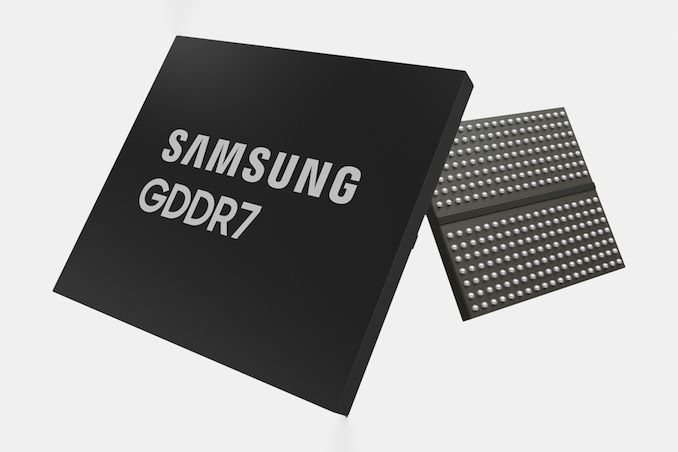The future of PC gaming just got a significant boost with the unveiling of GDDR7 memory by Micron Technology at Computex 2024. This next-generation memory standard promises to revolutionize graphics cards, pushing the boundaries of performance and efficiency. Here’s a deep dive into what GDDR7 offers and how it will reshape the gaming landscape.

Blazing-Fast Speeds and Unmatched Bandwidth
The defining feature of GDDR7 is its sheer power. Compared to its predecessor, GDDR6, GDDR7 boasts:
- Unprecedented Data Transfer Rates: It can transfer data at a staggering 32Gb/s, nearly double the speed of GDDR6’s 16Gb/s.
- Massive Bandwidth: With a bandwidth of 1.5Tb/s, GDDR7 surpasses GDDR6’s 768Gb/s by a significant margin. This translates to a smoother and more responsive gaming experience, especially for high-resolution and high-framerate gaming.
These improvements are a direct result of Micron’s innovative 1-beta technology and the implementation of a pulse-amplitude modulation (PAM) signal interface. This interface allows for transmitting three bits of data within two clock cycles, effectively increasing data transmission efficiency by 50% compared to GDDR6.
A Smoother, More Immersive Gaming Experience
The benefits of GDDR7 extend far beyond raw performance numbers. Here’s how it will directly impact your gaming experience:
- Higher Frame Rates: Expect significant frame rate boosts, especially in demanding titles at resolutions like 1080p, 1440p, and even 4K. Even with ray tracing enabled, GDDR7 promises a smoother and more visually stunning experience.
- Reduced Response Times: The faster data transfer speeds of GDDR7 translate to lower response times. This translates to crisper visuals and a more responsive gameplay experience, especially in fast-paced games.
- Improved Power Efficiency: Despite its increased performance, GDDR7 is surprisingly energy-efficient. Micron claims a 50% improvement in efficiency compared to GDDR6. This not only reduces power consumption during gameplay but also allows for cooler-running graphics cards.
When Can We Expect GDDR7 Graphics Cards?
While GDDR7 represents a significant leap forward, it won’t be immediately available in every graphics card. Here’s a breakdown of the timeline:
- Sample Shipments Begun: Micron has already started delivering test samples of GDDR7 memory to major manufacturers like AMD, Nvidia, and Intel.
- Implementation in Upcoming Flagships: We can expect to see GDDR7 first integrated into the high-end models of the next-generation graphics card series, such as the potential “Super” variants of Nvidia’s RTX 50 series or top-tier models in AMD’s Radeon RX 8000 lineup.
- Mainstream Adoption: Widespread adoption of GDDR7 in mainstream graphics cards will likely take some time. Full-scale production of GDDR7 is expected to begin by the end of 2024, and it might take several months for it to trickle down to budget-friendly graphics cards.
Unveiling the Future: What to Expect from GDDR7
The arrival of GDDR7 marks a significant turning point in graphics card technology. Here’s what this new standard paves the way for:
- Hyper-Realistic Gaming: With its increased memory bandwidth, GDDR7 opens doors for even more detailed textures, complex lighting effects, and higher resolution rendering, blurring the lines between reality and virtual worlds.
- Enhanced VR Experiences: The demanding nature of virtual reality (VR) requires immense processing power and memory bandwidth. GDDR7’s capabilities could revolutionize VR experiences, creating smoother visuals and faster loading times.
- Evolving AI in Games: Artificial intelligence (AI) is playing an increasingly important role in modern games, driving realistic enemy behavior and dynamic environments. GDDR7’s improved memory performance could pave the way for even more sophisticated AI in games.
FAQs:
Q: Will GDDR7 make my current graphics card obsolete?
A: Not necessarily. While GDDR7 offers substantial performance improvements, your current graphics card will likely remain functional for many games. However, if you’re looking to experience the latest titles at their highest settings and smoothest frame rates, upgrading to a GDDR7-equipped graphics card in the future could be a worthwhile investment.
Q: Are there any downsides to GDDR7?
A: While Micron claims improved power efficiency, it’s important to note that higher performance often comes at the cost of increased heat generation. Independent testing will be crucial to confirm the actual thermal performance of GDDR7 cards. Additionally, the initial adoption of GDDR7 will likely be limited to high-end models, potentially leading to a higher price point compared to GDDR6 counterparts.
Q: When should I upgrade to a GDDR7 graphics card?
A: The decision to upgrade depends on your individual needs and budget. If you’re satisfied with your current gaming experience, there’s no need to rush into an upgrade. However, if you’re looking for the absolute best performance for demanding games or future-proofing your system, waiting for a GDDR7-equipped graphics card in the high-end or upper-midrange segment might be a good strategy.
Q: Are there any alternatives to GDDR7?
A: While GDDR7 is currently the most advanced memory standard for graphics cards, other technologies are being explored. GDDR7X, a potential future iteration, is rumored to offer even higher bandwidths. Additionally, high-bandwidth memory (HBM) is another option, but its higher production cost typically limits its use to high-performance computing applications.




